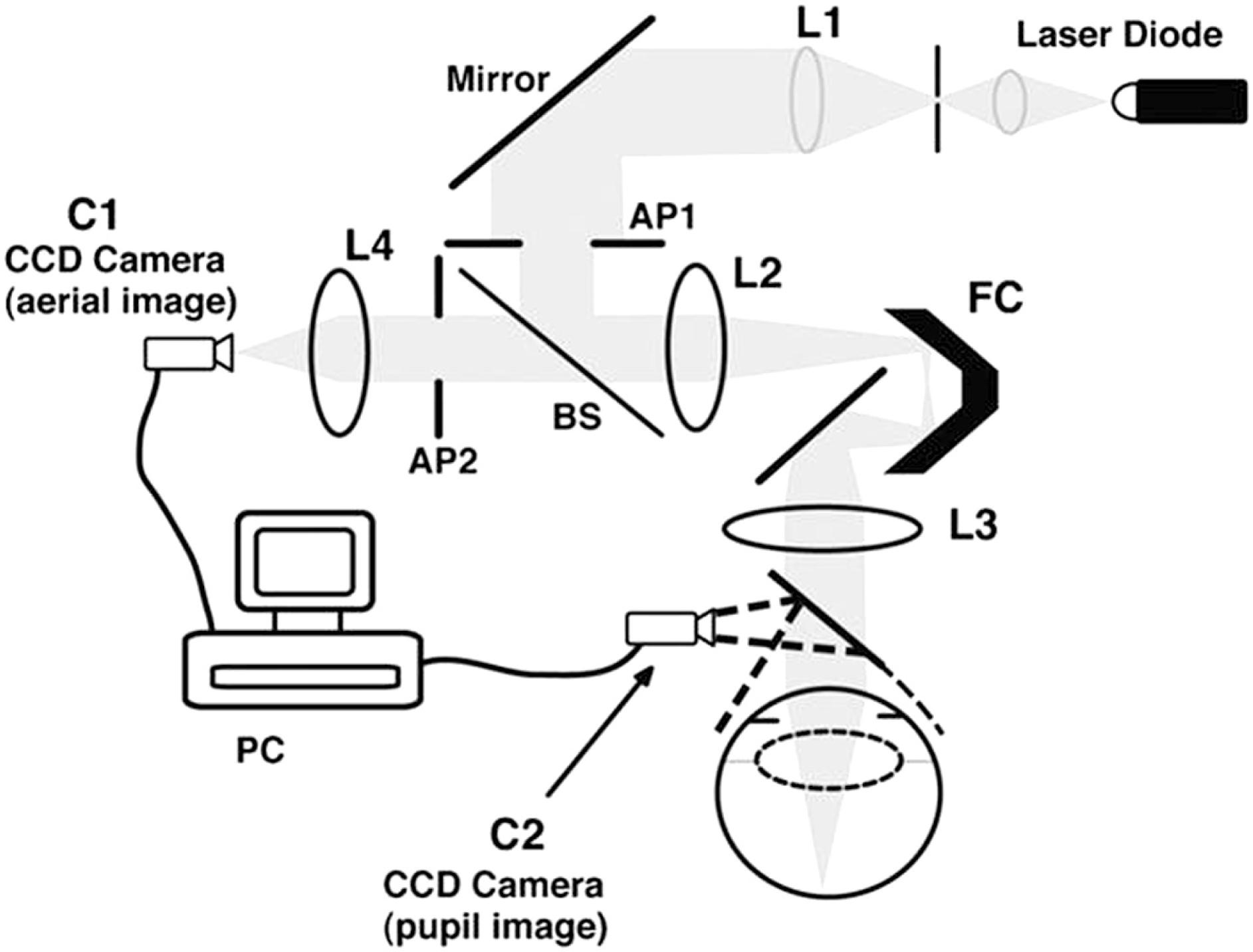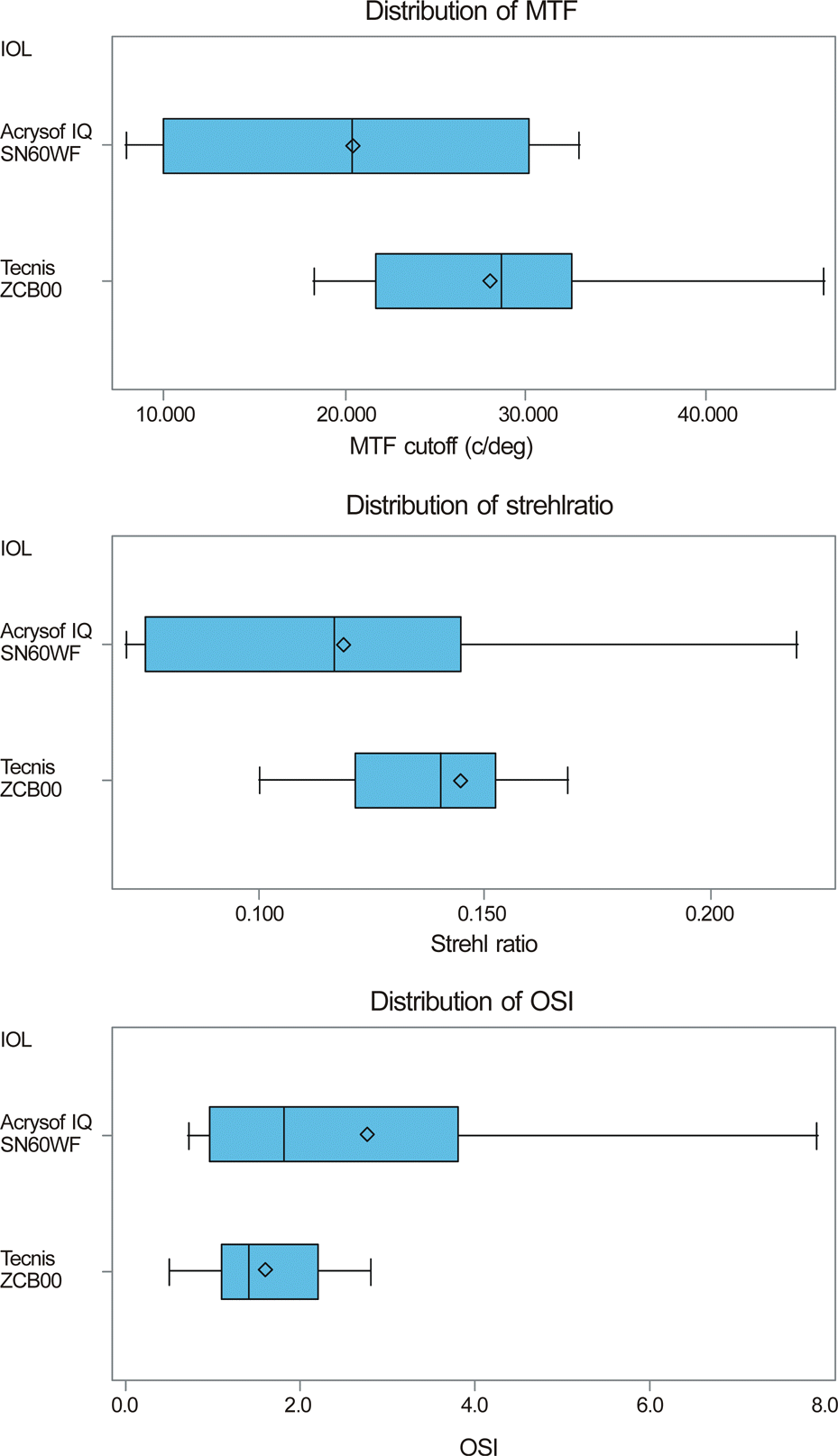Abstract
Purpose
To compare postoperative optical qualities between two types of 1-piece aspheric intraocular lenses using the double-pass technique.
Methods
Uncorrected visual acuity (UCVA), best corrected visual acuity (BCVA), and spherical equivalent were evaluated in the subject groups; the first which included 25 eyes implanted with Tecnis® ZCB00 and the second which included 16 eyes implanted with Acrysof® IQ SN60WF. In addition, modulation transfer function (MTF) cut-off, Strehl ratio, and objective scattering index (OSI) were measured 6 months after cataract surgery in the 2 subject groups using Optical Quality Analysis System (OQAS, Visiometrics S.L., Terrasa, Barcelona, Spain) which is based on the double-pass technique.
Results
There were no significant differences in the spherical equivalent, UCVA, BCVA, and OSI between the 2 groups. However, both the MTF cut-off, and Strehl ratio showed statistically significant differences. The MTF cut-off (28.0 ± 7.79 vs. 20.4 ± 9.51 c/deg, p = 0.025) and Strehl ratio (0.14 ± 0.04 vs. 0.12 ± 0.05, p = 0.042) were higher in the Tecnis® ZCB00- implanted group.
Conclusions
The difference in characteristics of intraocular lenses subtly affects the vision quality as measured by values such as MTF cut-off and Strehl ratio after cataract surgery. OQAS based on the double-pass technique is considered useful in more objective estimates of the real retinal image quality after cataract surgery which is difficult to explain simply by measuring visual acuity.
Go to : 
References
1. Werner L, Olson RJ, Mamalis N. New technology IOL optics. Ophthalmol Clin North Am. 2006; 19:469–83.
2. Tzelikis PF, Akaishi L, Trindade FC, Boteon JE. Spherical aberra-tion and contrast sensitivity in eyes implanted with aspheric and spherical intraocular lenses: a comparative study. Am J Ophthalmology. 2008; 145:827–33.

3. Kim SW, Ahn H, Kim EK, Kim TI. Comparison of higher order aberrations in eyes with aspherical or spherical intraocular lenses. Eye (Lond). 2008; 22:1493–8.

4. Bae HW, Kim EK, Kim TI. Spherical aberration, contrast sensi-tivity and depth of focus with three aspherical intraocular lenses. J Korean Ophthalmol Soc. 2009; 50:1639–44.

5. Park SJ, Wee WR, Lee JH, Kim MK. Comparison of wavescan aberrometer refraction to subjective manifest refraction and autorefractor. J Korean Ophthalmol Soc. 2009; 50:684–90.

6. Vilaseca M, Arjona M, Pujol J. . Optical quality of foldable monofocal intraocular lenses before and after injection: Comparative evaluation using a double-pass system. J Cataract Refract Surg. 2009; 35:1415–23.
7. Eom Y, Yoo E, Kang SY. . Change in efficiency of aspheric in-traocular lenses based on pupil diameter. Am J Ophthalmol. 2013; 155:492–8.e2.

8. Díaz-Doutón F, Benito A, Pujol J. . Comparison of the retinal image quality with a Hartmann-Shack wavefront sensor and a double-pass instrument. Invest Ophthalmol Vis Sci. 2006; 47:1710–6.
9. Norrby NE, Grossman LW, Geraghty EP. . Determining the imaging quality of intraocular lenses. J Cataract Refract Surg. 1998; 24:703–14.

10. Saad A, Saab M, Gatinel D. Repeatability of measurements with a double-pass system. J Cataract Refract Sur. 2010; 36:28–33.

11. Vilaseca M, Padilla A, Pujol J. . Optical quality one month af-ter verisyse and Veriflex phakic IOL implantation and Zeiss MEL 80 LASIK for myopia from 5.00 to 16.50 diopters. J Refract Surg. 2009; 25:689–98.

12. Artal P. Understanding aberrations by using double-pass techniques. J Refract Surg. 2000; 16:S560–2.

13. Artal P, Benito A, Pérez GM. . An objective scatter index based on double-pass retinal images of a point source to classify cataracts. PloS one. 2011; 6:e16823.

14. Lee J, Kim JH, Kim EK, Kim TI. Comparative study of clinical outcomes between 2 types of 3-piece aspheric intraocular lenses. J Korean Ophthalmol Soc. 2012; 53:43–8.

15. Beiko GH, Haigis W, Steinmueller A. Distribution of corneal spherical aberration in a comprehensive ophthalmology practice and whether keratometry can predict aberration values. J Cataract Refract Surg. 2007; 33:848–58.

16. Chantra S, Pachimkul P, Naripthaphan P. Wavefront and ocular spherical aberration after implantation of different types of asphe-ric intraocular lenses based on corneal spherical aberration. J Med Assoc Thai. 2011; 94(Suppl 2):S71–5.
17. Lee KM, Park SH, Joo CK. Comparison of clinical outcomes with three different aspheric intraocular lenses. Acta Ophthalmol. 2011; 89:40–6.

18. Ferrer-Blasco T. Effect of partial and full correction of corneal spherical aberration on visual acuity and contrast sensitivity. J Cataract Refract Surg. 2009; 35:949–51.

19. Salvatore S, Lupo S, Nebbioso M. . New insight into visual function with aspherical intraocular lenses (IOLs): Tecnis ZCB00 and Acrysof SN60WF. Int Ophthalmol. 2011; 31:417–9.

20. Jeong JH, Kim MK, Wee WR, Lee JH. Comparison of optical performances in eyes implanted with aspheric and spherical intra-ocular lenses after cataract surgery. J Korean Ophthalmol Soc. 2010; 51:1445–52.

Go to : 
 | Figure 1.Experimental diagram of the double-pass system. (AP1 = artificial pupil 1; AP2 = artificial pupil 2; BS = beam splitter; C1 = camera 1; C2 = camera 2; CCD = charge-coupled device; L1, L2, L3, L4, and L5 = lenses 1, 2, 3, 4; FC = focus corrector; BS = beam splitter; PC = per-sonal computer). |
 | Figure 2.Comparison of MTF cutoff, Strehl ratio, OSI between the 2 groups measured using OQAS 6 months after operation. MTF = modulation transfer function; OSI = objective scattering index; IOL = intraocular lens. |
Table 1.
Characteristics of the 2 aspheric intraocular lenses used in the study
Table 2.
Demographics of study groups
|
IOL groups |
||
|---|---|---|
| TECNIS® ZCB00 | Acrysof® IQ SN60WF | |
| Number of eyes | 25 | 16 |
| Sex (male:female) | 10:15 | 7:9 |
| Mean age (years) | 69.9 ± 10.1 | 67.0 ± 8.3 |
| OD:OS | 12:13 | 5:11 |
Table 3.
Visual acuity and refractive errors of the 2 groups 6 months after operation
| TECNIS® ZCB00 | Acrysof® IQ SN60WF | p-value* | |
|---|---|---|---|
| UCVA (log MAR) | 0.12 ± 0.21 | 0.12 ± 0.15 | 0.89 |
| BCVA (log MAR) | 0.06 ± 0.21 | 0.06 ± 0.10 | 0.56 |
| Refractive error (SE) | -0.22 ± 0.43 | -0.57 ± 1.03 | 0.68 |




 PDF
PDF ePub
ePub Citation
Citation Print
Print


 XML Download
XML Download